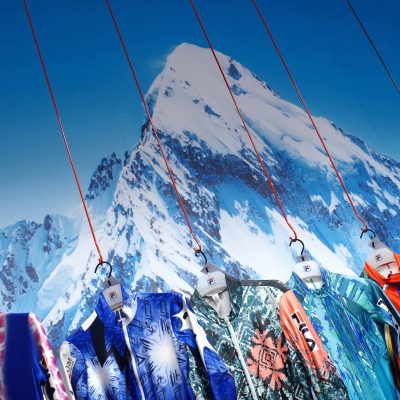
EFHA World 18.05.2021
14.08.2019
1980sfashion illustrationfashion magazine
Rediscovering a very 1980s way of showing fashion
Vanity was a magazine published in Italy by Condé Nast between 1980 and 1989. The so-called avant grade magazine was a project conceived by Anna Piaggi, an important and visionary fashion editor, as a “concept magazine” that she herself described as a mathematical axiom, a wonderful synthesis or observation collected in a short saying. The magazine was almost entirely illustrated, with a graphic language that mounted together images and words, configuring as a sort of narrative map of the complex and varied scenario of a pivotal moment for international fashion.
“It was a chance to step out of photography, and just work with illustrators. At that time, 1981 to 1984, it was probably a good idea I wanted to express the idea of fantasies, but the clothes were all tied up with advertising, so to give the clothes a new spirit, I commissioned illustrators, and this was very relieving. The English clothes could be photographed, but the Italian really needed interpretation.” (Anna Piaggi, interview appeared on Blitz number 49, January 1987)
The magazine at the beginning was built around the relationship between Anna Piaggi and Antonio Lopez, the most chameleonic among the fashion illustrators who worked in the 1980s. Antonio Lopez is an early talent; start studying fashion at the age of twelve, and his career takes off very early: just over twenty is already a celebrity among the offices New York Times, Harper’s Bazaar, Interview and Vogue, where illustrates editorials and collections. Lopez had the ability to transform clothes into a design: something that fascinated Rosita Missoni, with whom Lopez collaborated on several occasions, sketching the advertising campaigns for the brand. Lopez’s work was essentially a post-production – a sort of re-creation – on the collections seen in the fashion show: he was a connoisseur of the history of fashion, of the construction of clothes and what it means to create, and his illustrations managed to surpass reality in favor of the force of the trait, of the model, of the composition of the image.
In 1984, after the departure of Piaggi, who had built the magazine on the contributions of Alfa Castaldi, Vern Lambert and Karl Lagerfeld, and especially on her relationship with fashion illustrator Antonio Lopez, the artistic director Alberto Nodolini decided to change route and open the space to contaminations. Nodolini contacted the personalities of the Nuovo Fumetto Italiano (New Italian Comics), a genre that, from the mid-seventies, was safely marching towards the achievement of the status of postmodern avant-garde. In particular, the Valvoline Motorcomics group – born between 1982 and 1983 and composed by Daniele Brolli, Giorgio Carpinteri, Marcello Jori, Jerry Kramsky, Lorenzo Mattotti and Igor Tuveri (Igort) – found in the magazine a space where to experiment with different languages and styles, crafting a definition of fashion that was both imaginative and concrete. The group – whose components, more than illustrators, defined themselves as “visual operators” – was interested in fashion as an active component of cultural reality.
A magazine like Vanity does not present fashion, it creates it. It is no coincidence that Vanity is a culturally more advanced point among all the magazines in the sector, dedicating ample space to services on the trends of art and entertainment, proposing itself to a highly acculturated public according to a line that wants fashion combined with painting, to the performance, to the theater, to the great photography, and which makes a continuous use of references to all this to present the creations of the designers. Vanity creates fashion by imposing on objects that has a visual impact that goes beyond that of stylistic creations in itself, a much, much more mediated impact than that of any other magazine. The same fashion photography is often, in Vanity, more the presentation of an environment, of a situation, than of a garment of clothing. In short, you cannot browse this magazine to learn about clothes: fashion seems to be much more than just clothes. Fashion is that immense cultural construction that fills clothes with meaning, for example, which, presented in the eighties, a sixties-style dress acquires a meaning that is profoundly different from what it could have then. (Daniele Barbieri 1988)
Vanity was not the only editorial product that decides to illustrate fashion rather than relying solely on the photographic lens. Joyce and La Mode en Peintur and, two French magazines, are the best-known examples. La Mode en Peintur was a French magazine contemporary to Vanity (with whom he also shares some contributors, such as the French illustrator Hippolyte Romain), which portrayed the runway collections preferring drawing the photo report. The main differences between other illustrated magazines and Vanity were two: while those magazines chose contemporary fashion as a field of privileged interest, Vanity took care to build a complex discourse, updated on the articulated reality of art, culture and society. While the other magazines considered illustration as a mere and ‘simple’ mean to show fashion, though more original and less obvious than photography; on the other hand, Vanity managed to narrate the complexity of fashion with a sensitivity that often came from worlds other than that of fashion itself, causing collisions that generated new imaginations and unexpected meanings.
Vanity was published until 1989. It denied conformation and ‘great narratives’; it was recognizable thanks to its difference, to its will to portray the unexpected. Vanity was identifiable because it was never the same as itself, because it communicated fashion in unusual ways thanks to illustration and also to graphic expedients. The taste of the magazine changes at least three times in the course of its history, making it an important product and testimony of the atmosphere and ideas of the 1980s.